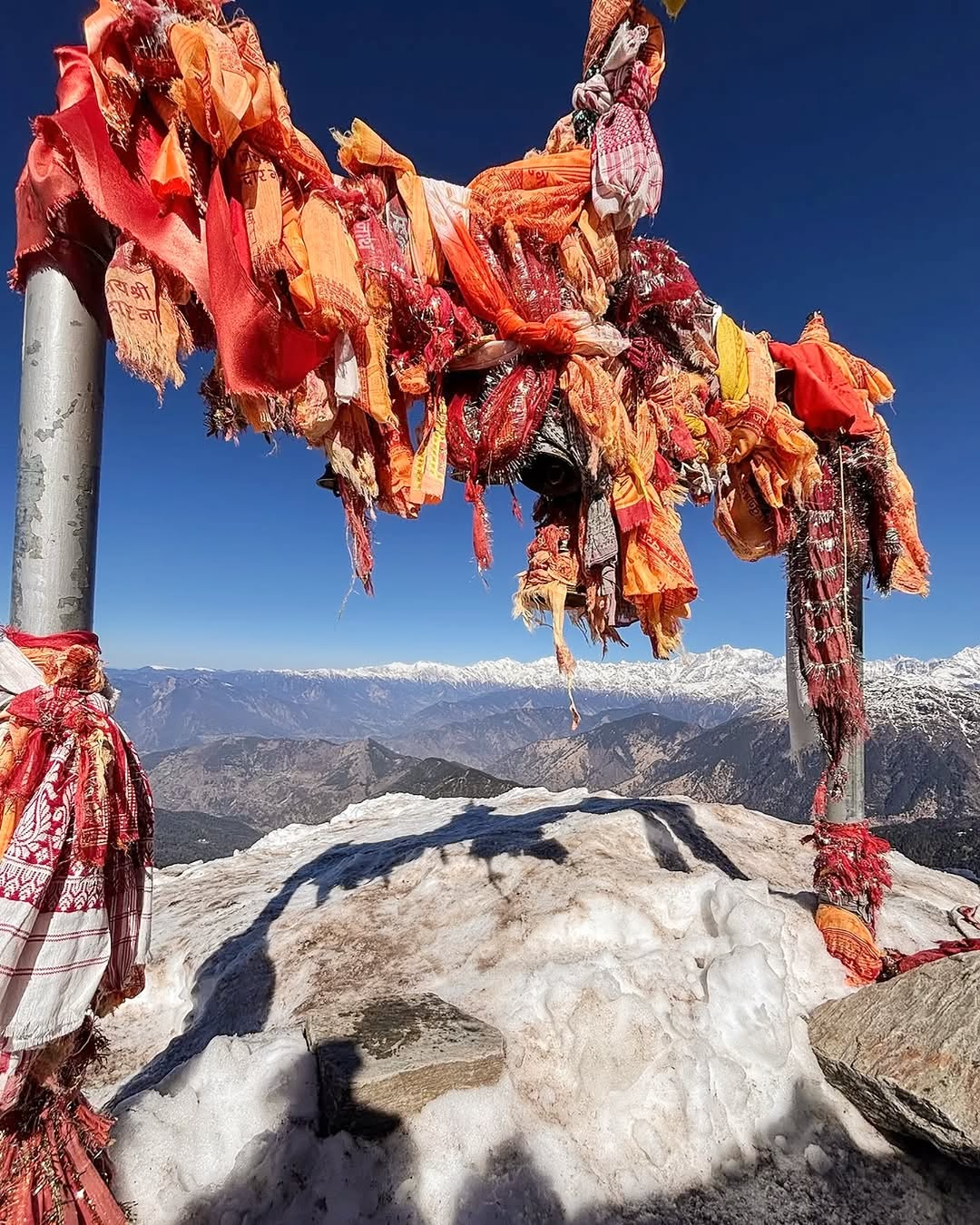From Delhi to the Top: A Step-by-Step Trek Plan to Chandrashila
Published on July 05, 2025
Chopta chandrashila trek from delhi, Are you a Delhi-based adventure seeker looking for an unforgettable Himalayan experience? Look no further than the Chopta-Chandrashila Trek , one of the most scenic and soul-stirring treks in Uttarakhand. This trek offers a perfect blend of natural beauty, spiritual vibes, and physical challenge — ideal for both beginners and seasoned trekkers.
Whether you're planning a Chopta tour package from Delhi , or aiming to conquer the Chandrashila summit trek , this guide will walk you through everything you need to know about how to plan your journey step-by-step — from travel logistics to trekking routes, budgeting tips, and more.
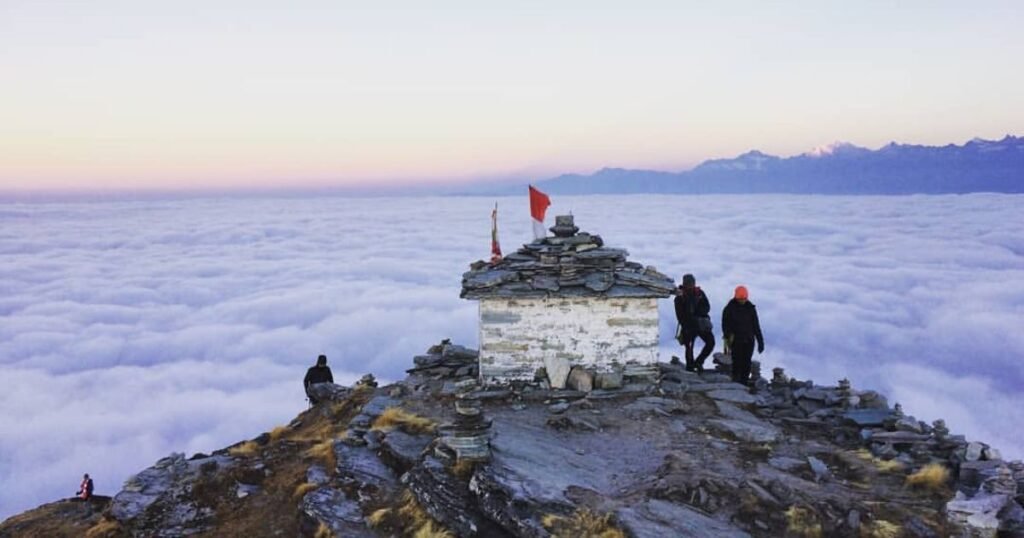
Path to the Peaks: Your Day-Wise Itinerary Unfolds
Day 0: Delhi to Rishikesh to Sari Village
- Departure: Start your journey from Botanical Garden Metro Station at 10:00 PM.
- Overnight Journey: Travel overnight towards Sari Village via Rishikesh.
- Stop at Devprayag: Witness the mesmerizing confluence of the Bhagirathi and Alaknanda rivers along the way.
Day 1: Sari Village to Deoriatal
- Arrival at Sari Village: Check into your homestay and take some time to freshen up.
- Trek to Deoriatal: Begin your trek to Deoriatal (2.5 km, approximately 1.5–2 hours).
- Enjoy Deoriatal: Soak in the serene beauty of the lake and the surrounding landscapes.
- Return to Sari Village: Head back to Sari Village and enjoy a peaceful evening.
Day 2: Sari Village to Tungnath & Chandrashila
- Breakfast: Start your day with a hearty breakfast at your homestay.
- Drive to Chopta: A scenic drive of about 1 hour from Sari Village.
- Trek to Tungnath Temple: Embark on a 3.5 km trek to the sacred Tungnath Temple.
- Summit Chandrashila: Extend your trek by 1.5 km to reach the breathtaking Chandrashila summit.
- Return to Chopta/Sari: After the trek, return to Chopta or Sari for an overnight stay at the campsite.
Day 3: Chopta to Delhi
- Breakfast: Enjoy an early breakfast at your campsite in Chopta.
- Departure: Begin your journey back to Delhi in the early morning.
- Visit Dhari Devi Temple: Stop by the revered Dhari Devi Temple en route.
- Arrival in Delhi: A long drive of approximately 10–12 hours marks the end of your adventure.
Step 1: Starting from Delhi – Choosing Your Travel Mode
Most Chopta tour packages from Delhi include transportation via shared cabs, private taxis, or buses to Rishikesh or Haridwar. The road journey from Delhi to Chopta is approximately 350 km , taking around 8–9 hours depending on traffic and road conditions.
Pro Tip: Many Tungnath trek packages from Delhi or Rishikesh offer doorstep pickup and drop-off services, making it hassle-free for solo travelers and groups alike.
Step 2: Reaching Chopta – The "Mini Switzerland" of India
Once you reach Sari village (near Ukhimath), you’ll drive up to Chopta , often called the “Mini Switzerland” of Uttarakhand due to its lush meadows and panoramic views of the Himalayas.
Here, you can opt for any of the following:
- Chopta Tungnath trek
- Chopta Tungnath trek from Delhi
- Chopta ChandraShila trek
- Chopta ChandraShila trek from Delhi
Chopta serves as the base camp for both the Tungnath Temple trek and the ultimate climb to Chandrashila Peak .
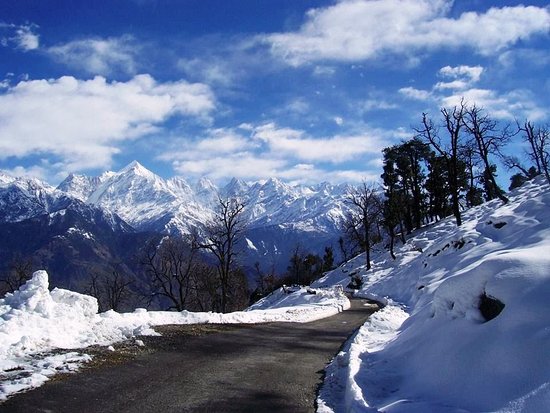
Step 3: Tackling the Tungnath Temple Trek
The Tungnath trek distance is approximately 3.5 km from Chopta and takes about 2–3 hours to complete. It’s moderately challenging and passes through pine forests and alpine meadows.
Tungnath is not just a trek destination but also a sacred site — it’s home to the Tungnath Temple , the highest Shiva temple in the world. Many Tungnath trek packages from Haridwar , Rishikesh , or Dehradun include guided visits to this holy shrine.
Step 4: Summiting Chandrashila – The Crown of the Trek
After reaching Tungnath, the next leg is the Chandrashila trek , which spans around 1.5 km and takes about 45 minutes to an hour. The final ascent leads you to the majestic Chandrashila Peak , standing at over 3,690 meters above sea level.
This Chandrashila summit trek rewards you with breathtaking 360-degree views of the Garhwal Himalayas, including peaks like Nanda Devi, Kedarnath, and Chaukhamba .
Best Time to Go on a Chopta-Chandrashila Trek
The best months for the Chopta-Chandrashila trek are:
- March to June : Lush greenery and pleasant weather.
- September to November : Clear skies and post-monsoon bloom.
- December to February : Snow-laden trails for winter lovers.
Avoid visiting during the monsoon season (July-August) due to landslides and slippery paths.
What to Pack for the Chopta-Tungnath-Chandrashila Trek
Here’s a quick checklist:
- Sturdy trekking shoes
- Warm clothing (especially in winters)
- Water bottle and snacks
- First aid kit
- Sunscreen, sunglasses, cap
- Power bank and camera
If you've booked a Chopta ChandraShila trek package , most essentials might be included, especially if camping or homestay accommodation is part of the deal.
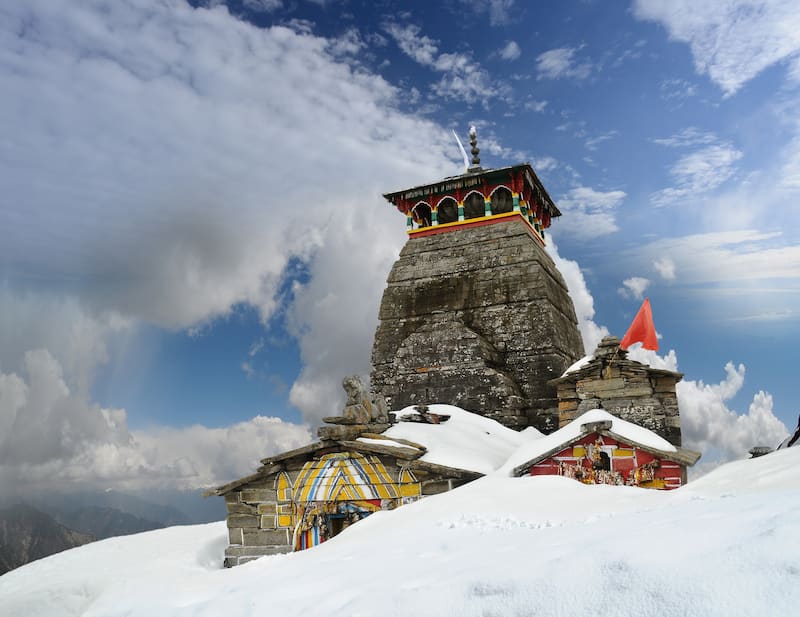
Where to Stay: Accommodations in Chopta & Chandrashila – A Traveler’s Guide
Tucked away in the serene Himalayas of Uttarakhand, Chopta is not just a gateway to the majestic Chandrashila Trek , but also a peaceful retreat offering cozy stays that blend nature with comfort. Whether you're a solo traveler, couple, or part of a group, finding the right accommodation in Chopta can enhance your overall trekking experience.
While Chandrashila Peak itself is a summit and doesn’t have accommodations due to its high altitude and rugged terrain, Chopta serves as the perfect base camp — offering everything from budget homestays to luxury cottages.
Let’s explore the best accommodations in Chopta , along with tips on booking the perfect stay during your Chopta-Chandrashila trek .
Types of Accommodations in Chopta
1. Budget Homestays & Guesthouses
Perfect for backpackers and budget travelers, these are run by locals and offer simple yet comfortable rooms with basic amenities like hot water, attached bathrooms, and meals on request.
- Ideal for those booking a Chopta tour package for couples or solo adventurers.
- Often included in Chopta ChandraShila trek packages at affordable rates.
Average Price : ₹800–₹1,500 per person per night (inclusive of meals)
2. Mid-Range Resorts & Lodges
These properties offer better facilities like heating, Wi-Fi (limited), clean bedding, and scenic views. Some even have bonfire setups and dining halls serving local Garhwali cuisine.
- Great for families or small groups.
- Available through Chopta tour packages from Delhi , Haridwar, or Rishikesh.
Average Price : ₹1,500–₹3,000 per person per night
3. Luxury Cottages & Private Stays
For those looking for more privacy and comfort, luxury cottages and boutique-style stays are emerging in and around Chopta. These are ideal for romantic getaways or small groups seeking premium experiences.
- Often included in deluxe Chopta tour packages .
- May include pick-up/drop-off, guided treks, and curated meals.
Average Price : ₹3,500–₹6,000 per person per night
4. Camping Options
During peak seasons (March–June & September–November), several Tungnath trek packages from Delhi include camping near Chopta. Tents come with sleeping bags, mats, and shared washrooms.
- Offers a rustic and immersive experience.
- Popular among adventure enthusiasts and photographers.
Average Price : ₹1,200–₹2,500 per person (with meals)
How to Book Accommodations in Chopta
Since Chopta is gaining popularity among trekkers, it's advisable to book your stay in advance , especially during weekends and holidays.
You can:
- Book directly via guesthouse owners (Google listings help).
- Choose Chopta ChandraShila trek packages that include accommodation.
- Use travel platforms like GoStaa, Yatra, or MakeMyTrip for verified options.
Pro Tip: If you're opting for a Chopta tour package from Delhi , most operators handle accommodation, transport, and trek permits in one go.
What to Expect During Your Stay
- Basic to moderate amenities depending on the property.
- Limited mobile network and internet connectivity.
- Cold weather in winters; ensure your stay has heating facilities.
- Meals usually include simple vegetarian food (non-veg may be limited).
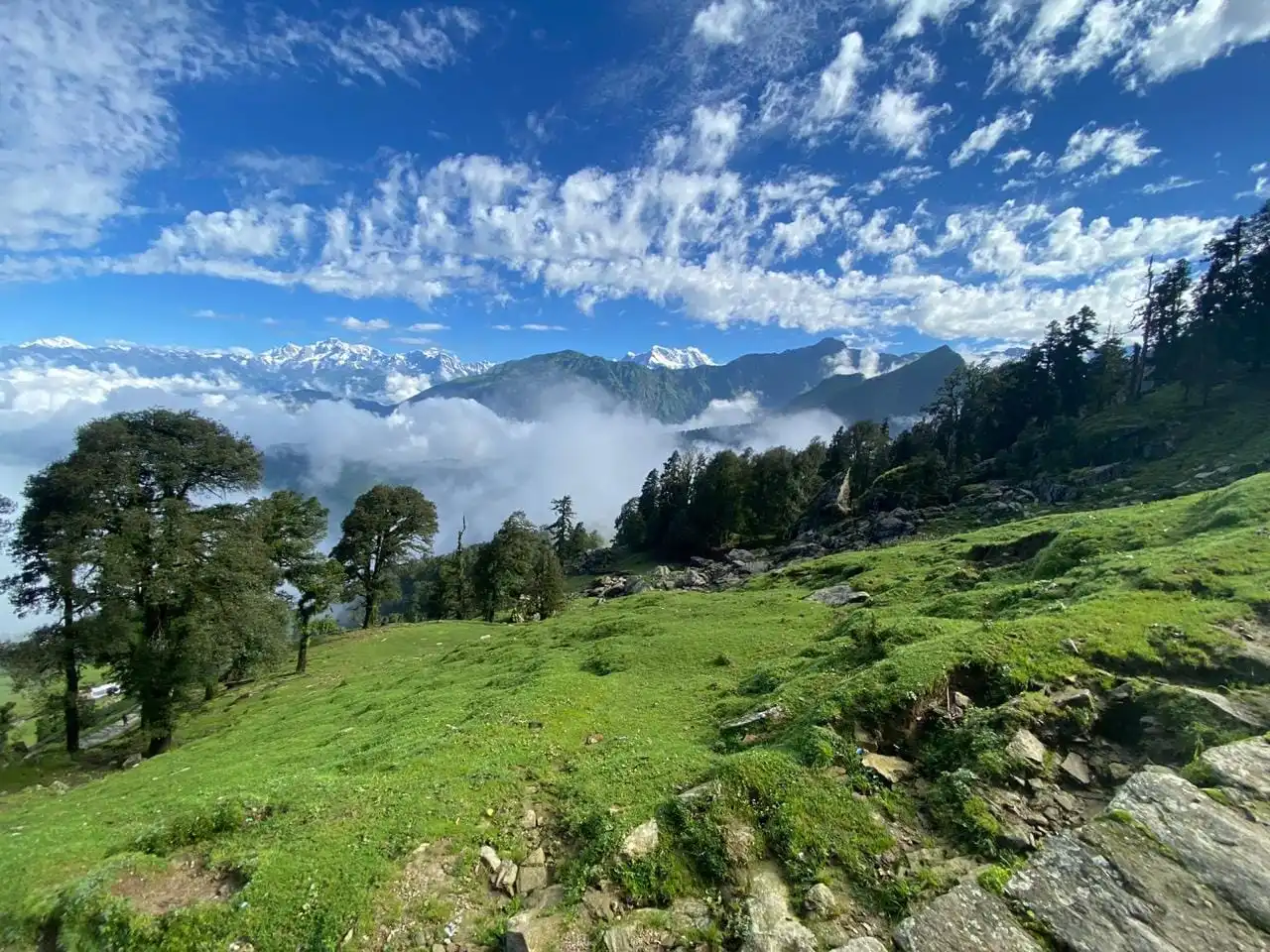
Understanding Weather in Chopta & Chandrashila: A Detailed Guide
Nestled in the Garhwal Himalayas of Uttarakhand, Chopta and Chandrashila are two of the most enchanting destinations for trekkers and nature lovers. Known for their breathtaking landscapes, serene environment, and spiritual significance, these locations offer an unforgettable experience — but only if you're prepared for the weather!
Whether you're planning a Chopta-Chandrashila trek , booking a Chopta tour package from Delhi , or curious about the Tungnath temple trek , understanding the weather in Chopta and Chandrashila is essential to ensure a safe and enjoyable trip.
In this guide, we’ll take you through the seasonal variations , what to expect during different times of the year, how the weather affects the Tungnath trek , and tips for packing accordingly. This will help you choose the best time to visit and ensure you make the most of your Himalayan adventure.
Overview of Weather in Chopta & Chandrashila
Elevation and Climate
Chopta sits at an elevation of approximately 2,680 meters (8,790 feet) above sea level, while Chandrashila Peak rises to over 3,690 meters (12,100 feet) . Due to this high altitude, the climate in Chopta and Chandrashila is significantly cooler than the plains of North India.
The region experiences four major seasons:
- Summer (March to June)
- Monsoon (July to August)
- Post-Monsoon/Autumn (September to November)
- Winter (December to February)
Each season offers a unique charm and set of challenges for trekkers and travelers.
1. Summer Season – March to June
Temperature Range:
- Chopta : 10°C to 22°C
- Chandrashila : 5°C to 15°C
Characteristics:
This is the best time to visit Chopta and Chandrashila for trekking and outdoor activities. The weather is pleasant, with clear skies, blooming meadows, and panoramic mountain views.
- Chopta comes alive with lush greenery and wildflowers.
- The Tungnath trek becomes more accessible as snow starts melting by late March.
- The Chandrashila summit trek is less strenuous compared to winter months.
Trekking Conditions:
- Ideal for beginners and families.
- Trails are mostly dry and easy to navigate.
- Perfect for photography, birdwatching, and camping.
2. Monsoon Season – July to August
Temperature Range:
- Chopta : 15°C to 25°C
- Chandrashila : Not recommended due to heavy snow and rain
Characteristics:
Monsoon brings heavy rainfall to the region, making the Tungnath trek and Chandrashila trek risky and potentially dangerous.
- Landslides and slippery trails are common.
- Visibility is low due to mist and clouds.
- Accommodations may remain closed or limited.
Reasons to Avoid:
- Treacherous terrain and blocked paths.
- Risk of leeches during monsoon hikes.
- Limited connectivity and transport options.
Accommodation:
Only a few homestays remain open, and most Chopta tour packages are not available during this time.
3. Post-Monsoon / Autumn – September to November
Temperature Range:
- Chopta : 8°C to 20°C
- Chandrashila : 2°C to 10°C
Characteristics:
Autumn is another ideal season for visiting Chopta and Chandrashila. The rains subside, and the landscape turns into a vivid mix of greens, browns, and golds.
- Crisp air and clear skies offer stunning views of the Himalayas.
- Trails are clean and relatively safe after the monsoon.
- Spiritual vibes are heightened as pilgrims head to nearby temples like Kedarnath and Tungnath .
Trekking Experience:
- Moderate difficulty level.
- Great for photography and sunrise/sunset views from Chandrashila.
- Less crowded than summer, offering a peaceful retreat.
What to Pack:
- Warm clothing (fleece jackets, thermals)
- Waterproof trekking shoes
- Windproof layers
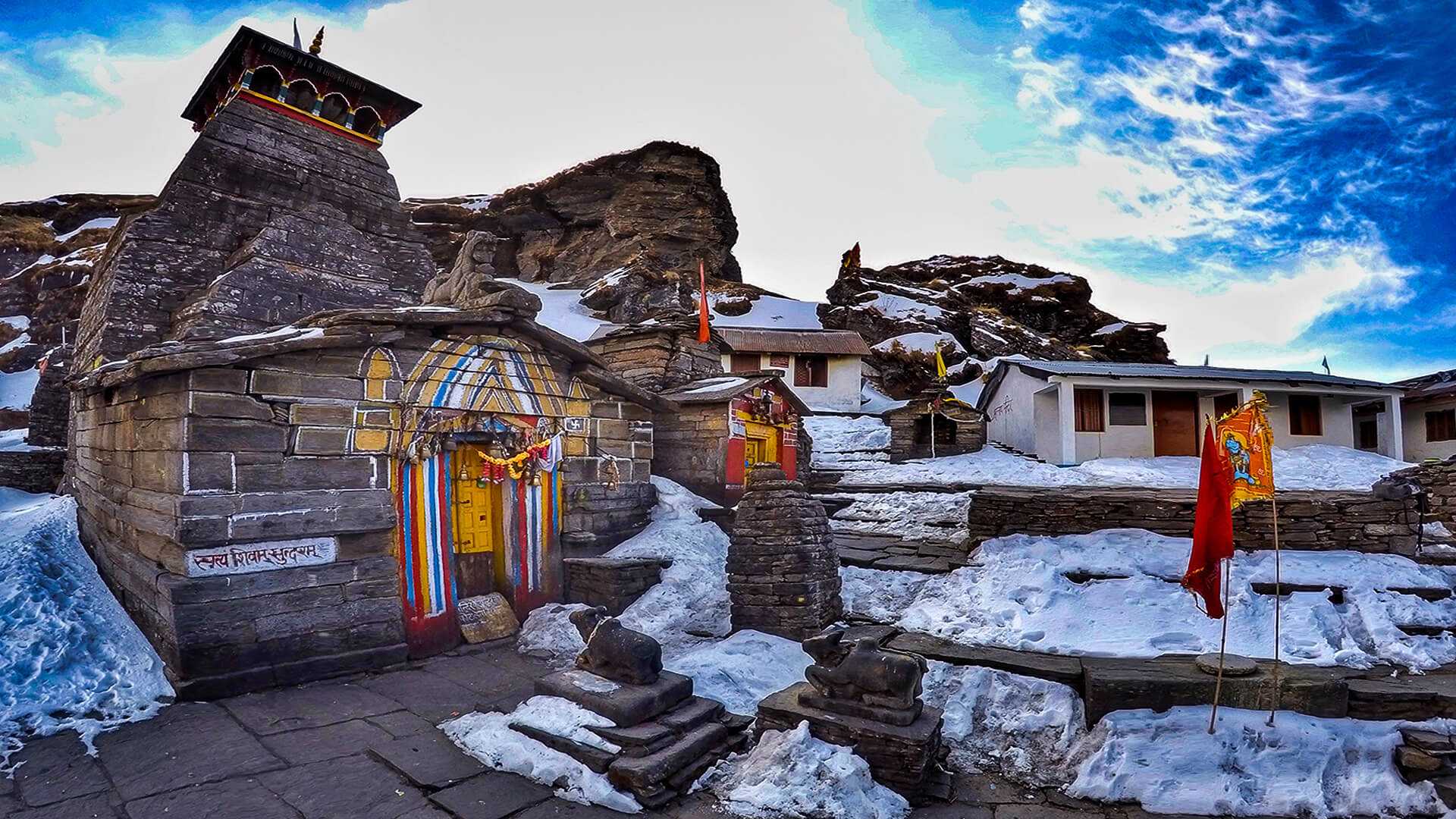
4. Winter Season – December to February
Temperature Range:
- Chopta : -2°C to 10°C
- Chandrashila : -5°C to 5°C
Characteristics:
Winter transforms Chopta and Chandrashila into a snow-covered paradise . For experienced trekkers and adventure enthusiasts, this season offers a magical experience.
- Snow-laden trails and frozen waterfalls.
- Breathtaking views of snow-draped peaks.
- Fewer crowds and more privacy.
Trekking Conditions:
- Challenging due to icy paths and snow cover.
- Requires proper gear, stamina, and sometimes a guide.
- The Tungnath trek distance becomes longer and tougher due to snow accumulation.
Accommodation:
Some homestays and resorts in Chopta remain open during winters, offering bonfires, hot meals, and cozy stays.
- Chopta tour package for couples becomes popular during this romantic season.
- Many Tungnath trek packages from Delhi also include winter-specific itineraries.
Impact of Weather on Trekking Routes
Tungnath Temple Trek
- Distance: ~3.5 km from Chopta
- Weather Impact:
- Summer/Autumn: Clear and easy trails
- Winter: Snow-covered; requires extra caution
- Monsoon: Slippery and unsafe
Chandrashila Summit Trek
- Distance: ~1.5 km from Tungnath
- Weather Impact:
- Summer/Autumn: Best visibility and manageable climb
- Winter: High winds, snow, and cold; suitable only for experienced trekkers
- Monsoon: Closed due to risk of landslides
Note: Always check local weather updates before starting the trek. Some Chopta ChandraShila trek packages include real-time updates and safety measures.
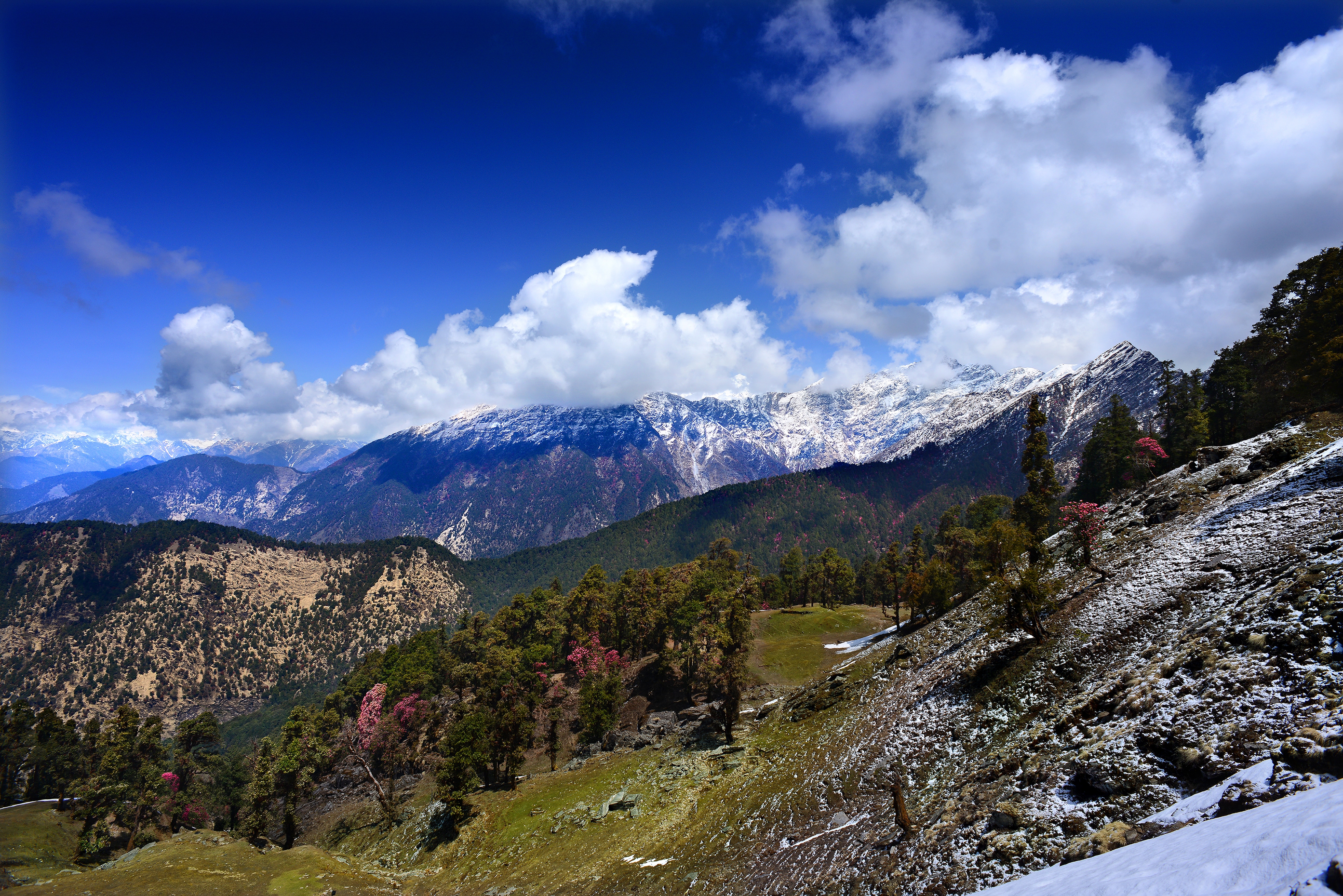
Must-Try Adventure Activities in Chopta & Chandrashila
Nestled amidst the majestic Himalayas of Uttarakhand, Chopta and Chandrashila are not just breathtaking destinations — they're adventure hubs waiting to be explored. Whether you're a seasoned trekker or a first-time traveler from Delhi , this region offers a variety of thrilling outdoor experiences that will leave you spellbound.
Known as the "Mini Switzerland of India" , Chopta serves as the base camp for one of the most popular treks in the Garhwal region — the Tungnath-Chandrashila Trek . But beyond the famous summit lies a world full of hidden trails, spiritual spots, and adrenaline-pumping adventures.
Here are the top adventure activities to do in Chopta and Chandrashila , perfect for nature lovers, thrill-seekers, and spiritual explorers alike:
1. Tungnath Temple Trek
The Tungnath Temple Trek is the heart of any Chopta-Chandrashila trek itinerary. At an elevation of 3,680 meters , Tungnath is not only the highest Shiva temple in the world but also a sacred stop on the Panch Kedar Yatra .
- Distance : ~3.5 km from Chopta
- Difficulty Level : Easy to Moderate
- Highlights : Ancient temple, panoramic mountain views, serene forest paths
Pro Tip : Start early in the morning to avoid crowds and enjoy the sunrise view from the temple premises.
2. Chandrashila Summit Trek
From Tungnath, the trail continues upward to the Chandrashila Peak , standing at over 3,690 meters . Known as the Chandrashila Summit Trek , this final leg rewards trekkers with a 360-degree view of the Himalayan ranges including Nanda Devi, Kedarnath, and Chaukhamba peaks .
- Distance : ~1.5 km from Tungnath
- Difficulty Level : Moderate (can be challenging in winter)
- Highlights : Sunrise/sunset views, snow trekking (in winters), wildflower meadows (in summers)
Pro Tip : Carry trekking poles for better balance, especially during snowy or slippery conditions.
3. Horse Riding in Chopta
For those who want to experience the beauty of Chopta without the physical strain of trekking, horse riding is a great alternative. You can ride up to Tungnath or even partway toward Chandrashila depending on your stamina and budget.
- Cost : ₹500–₹1,500 per horse (varies by season)
- Best For : Elderly travelers, kids, or those short on time
Note: Always negotiate the price before starting the ride and ensure the horses are well-maintained.
4. Camping in Chopta
Camping under the starlit sky surrounded by pine forests and alpine meadows is a dream come true for many. During peak seasons (March–June & September–November), several Chopta tour packages include camping options near the village or along the trek route.
- Types of Camps : Basic tents, luxury glamping setups
- Activities Included : Bonfire, music nights, stargazing, bonfire storytelling
Tip: Book a camping-inclusive Chopta ChandraShila trek package for a hassle-free experience.
5. Photography & Nature Walks
Chopta is a paradise for photographers and nature lovers. From misty mornings to vibrant sunsets, every moment here feels like a postcard.
- Popular Spots :
- Deoria Tal (nearby lake with reflection of mountains)
- Chopta meadows
- Chandrashila viewpoint
- Best Time for Photography : Early morning and late evening
Tip: Carry a wide-angle lens for capturing landscapes and a tripod for night sky photography.
6. Birdwatching in Chopta
With its rich biodiversity, Chopta is home to several species of birds, making it a haven for birdwatchers. The dense pine and oak forests are filled with chirping Himalayan birds like the Himalayan Monal, Cheer Pheasant, and various species of thrushes and warblers .
- Best Season : Spring and Autumn
- Ideal Gear : Binoculars, field guidebook, camera with zoom lens
Pro Tip : Wake up early for the best bird activity and carry snacks for long hours in the wild.
7. Short Nature Trails Around Chopta
If you’re staying in Chopta for a day or two, explore the local trails that lead through meadows, forests, and small villages. These walks offer peace, solitude, and stunning natural beauty.
- Popular Trails :
- Chopta to Mandakini River
- Chopta to Deoria Tal (6 km one-way)
- Forest walks around Tunganath
Tip: Combine your walk with a visit to nearby temples or waterfalls for a more enriching experience.
8. Winter Snow Trekking
Winter transforms Chopta and Chandrashila into a snowy wonderland. If you're visiting between December and February , don’t miss the chance to go snow trekking .
- Best Routes : Chopta to Tungnath (snow-covered), Chandrashila viewpoint
- Essential Gear : Gaiters, crampons, insulated boots, thermal wear
Pro Tip : Join a winter-specific Chopta tour package from Delhi that includes expert guides and safety gear.
9. Visit Nearby Deoria Tal
Just 6 km from Chopta lies Deoria Tal , a pristine alpine lake known for its mirror-like surface reflecting the surrounding snow-capped peaks.
- Distance from Chopta : ~6 km (1.5–2 hours walk)
- Adventure Level : Easy to moderate
- Highlights : Reflection of Chaukhamba peaks, peaceful environment
Tip: Stay overnight near the lake for a magical sunrise experience.
10. Explore Nearby Villages and Culture
Take some time to interact with the locals and explore the rural charm of the Himalayan villages around Chopta. Experience the simple lifestyle, traditional architecture, and warm hospitality of the Garhwali people.
- Villages to Explore : Sari, Ukhimath, Chopta itself
- Cultural Highlights : Local cuisine, folk music, handicrafts
Tip : Try local dishes like Chainsoo, Aloo Ke Gutke, and Bal Mithai during your stay.

The Hidden History of Chopta & Chandrashila – A Journey Through Time
While today Chopta and Chandrashila are celebrated as premier trekking destinations in Uttarakhand, their significance runs much deeper than just scenic beauty and adventure. These sacred Himalayan regions have a rich historical and mythological legacy , deeply intertwined with Hindu traditions , ancient pilgrimage routes, and spiritual lore.
From being part of the legendary Panch Kedar Yatra to offering breathtaking views of peaks named after celestial beings, Chopta and Chandrashila have long been revered by saints, sages, and devotees alike.
In this article, we’ll explore the historical roots, cultural importance, and mythological significance of Chopta and Chandrashila — perfect for those planning a Chopta-Chandrashila trek from Delhi , booking a Chopta tour package , or simply curious about the region’s hidden past.
Historical Background of Chopta
Origins and Early Mentions
Nestled at an altitude of 2,680 meters (8,790 feet) in the Rudraprayag district of Uttarakhand, Chopta has historically served as a resting point for pilgrims and trekkers heading towards the Kedarnath Temple and other sacred sites in the Garhwal Himalayas.
Though not directly mentioned in ancient scriptures like the Vedas or Puranas, Chopta gained prominence as a gateway to the Tungnath Temple , one of the five temples in the Panch Kedar circuit — a pilgrimage route dedicated to Lord Shiva.
Connection with Panch Kedar Yatra
The Panch Kedar Yatra is a revered Hindu pilgrimage that involves visiting five sacred Shiva temples scattered across the Garhwal region:
- Kedarnath
- Tungnath
- Rudranath
- Madhyamaheshwar
- Kalpeshwar
Of these, Tungnath , located just 3.5 km uphill from Chopta, holds immense religious significance. According to legend, Lord Shiva took the form of a bull to escape the Pandavas, who were seeking his blessings after the Mahabharata war. Parts of his body appeared at different locations, and his arms manifested at Tungnath .
Thus, Chopta became an essential stopover for devotees en route to Tungnath, eventually evolving into a small but vibrant settlement catering to both pilgrims and adventurers.
The Mythology Behind Chandrashila
Meaning of "Chandrashila"
The name "Chandrashila" is derived from two Sanskrit words:
- "Chandra" meaning Moon
- "Shila" meaning Rock or Stone
According to local legends, the Moon God (Chandra Dev) meditated here to seek forgiveness from Lord Shiva for neglecting his duties. It is believed that he performed intense penance on this very peak, which came to be known as Chandrashila — the stone of the moon.
Spiritual Significance
Standing at over 3,690 meters (12,100 feet) , Chandrashila is more than just a trekking destination — it is considered a powerful energy point where cosmic vibrations are said to be stronger. Many yogis and ascetics visit this place for meditation and spiritual awakening.
It is also believed that the entire Himalayan range visible from Chandrashila — including Nanda Devi, Chaukhamba, and Kedarnath peaks — represents the divine abode of Lord Shiva.
Role in Ancient Pilgrimage Routes
Before modern roads and tourism infrastructure developed, Chopta was a remote, untouched region known only to locals and spiritual seekers. However, its strategic location made it a crucial junction between the Kedarnath Valley and the Uttarkashi-Garhwal belt.
Ancient sadhus, monks, and pilgrims used to pass through Chopta while traveling to and from the holy shrines of Kedarnath , Tungnath , and Rudranath . Over time, as foot traffic increased, small settlements and rest houses emerged, laying the foundation for what is now a bustling base camp for trekkers.
Today, Chopta serves not only as a spiritual waypoint but also as the starting point for the Chandrashila Summit Trek , attracting thousands of adventure enthusiasts every year.
Chopta and Chandrashila in Modern Times
Rise as a Trekking Destination
Although Chopta had always been a quiet village, its popularity soared in the early 2000s when trekking companies began promoting the Tungnath-Chandrashila Trek as one of the most accessible high-altitude treks in India.
Its proximity to major cities like Delhi (approx. 350 km) , coupled with relatively moderate difficulty levels, made it a favorite among weekend trekkers and urban explorers.
Now, Chopta tour packages from Delhi , Haridwar, Rishikesh, and Dehradun** are widely available, offering everything from budget-friendly trips to luxury camping experiences.
Cultural & Environmental Preservation
With rising tourism, local communities have become active participants in preserving both the natural environment and cultural heritage of Chopta and Chandrashila.
Homestays, eco-lodges, and community-run guesthouses have replaced mass tourism, ensuring sustainable development while maintaining the region’s authenticity.
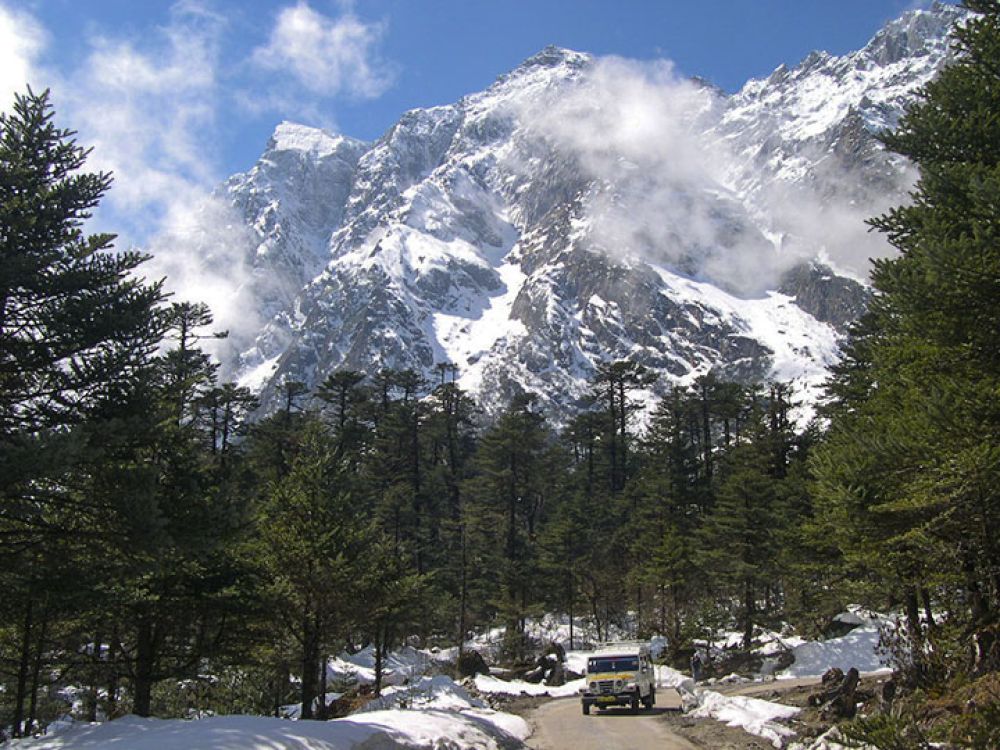
Legends Associated with Chandrashila Peak
One of the most popular legends associated with Chandrashila speaks of King Chandravarma , a devout follower of Lord Shiva.
As the story goes, the king once insulted a sage, who cursed him with leprosy. In search of a cure, he reached Chandrashila and meditated under harsh conditions. Moved by his devotion, Lord Shiva appeared before him and blessed him with healing powers.
Since then, Chandrashila has been regarded as a place of healing and spiritual transformation , drawing seekers from all over the world.
Chopta Tour Packages and Their Historical Appeal
Many modern Chopta tour packages now include visits to historical and cultural spots alongside adventure activities. Whether you're opting for a Chopta ChandraShila trek package , a spiritual pilgrimage trip , or a couple-friendly getaway , understanding the history behind these places adds depth to your journey.
Some popular offerings include:
- Heritage Walks in Sari & Ukhimath
- Cultural Experiences with Local Families
- Spiritual Talks at Tungnath Temple
- Guided Treks with Historical Narration

"From Earth to Sky: The Soulful Journey of Chopta & Chandrashila"
Chopta and Chandrashila are more than just destinations — they are experiences carved in mist, myth, and mountains. Whether you're drawn by the thrill of the trek, the serenity of nature, the whispers of ancient legends, or the call of spiritual awakening, this Himalayan gem offers something for every soul.
From the lush meadows of Chopta to the sky-touching summit of Chandrashila, each step tells a story — of devotion, adventure, resilience, and unity with nature. It’s a journey that begins in the heart of Delhi but ends amidst the clouds, where time stands still and the only sound is the wind carrying centuries of wisdom.
So whether you're planning a Chopta tour package from Delhi , preparing for the Tungnath-Chandrashila trek , or simply dreaming of snow-capped peaks and starlit skies, remember: Chopta isn’t just a place on the map — it’s a destination in the soul.
Let the mountains guide you. Let the silence speak to you. And let Chopta and Chandrashila remind you what it truly means to feel alive.
Frequently Asked Questions:
1. What is the best time to visit Chopta & Chandrashila?
The best time is March to June (summer) and September to November (autumn) for pleasant weather and clear views.
2. How difficult is the Chandrashila trek?
It’s moderate , suitable for beginners with basic fitness. The trek from Chopta to Chandrashila is around 5 km (3.5 km to Tungnath + 1.5 km to Chandrashila) .
3. Is it possible to trek in winter?
Yes. Winter treks (December–February) offer snow-covered trails but require proper gear and caution due to icy paths.
4. Are there accommodations in Chopta?
Yes, Chopta offers budget homestays, mid-range lodges, luxury cottages, and camping options during peak seasons.
5. Is it safe to trek during monsoon?
Not recommended. Heavy rainfall makes trails slippery and prone to landslides. Most Chopta tour packages avoid this season (July–August).
6. How to reach Chopta from Delhi?
Chopta is around 350 km from Delhi , reachable by road via Haridwar or Rishikesh (8–9 hours by car/bus).
7. What is the significance of Tungnath Temple?
Tungnath is the highest Shiva temple in the world and part of the sacred Panch Kedar Yatra . It's believed Lord Shiva appeared here as arms.
8. Can I camp in Chopta or near Chandrashila?
Yes, camping is popular in Chopta during summer and autumn. However, no accommodation or camping is available at Chandrashila due to high altitude.
9. What is the cost of a Chopta-Chandrashila tour package?
Budget packages start from ₹7,000/person, while deluxe or couple packages can range between ₹12,000–₹25,000/person depending on inclusions.
10. What other activities can I do besides trekking?
Horse riding, birdwatching, photography, visiting Deoria Tal, exploring nearby villages, and cultural immersion with locals.
